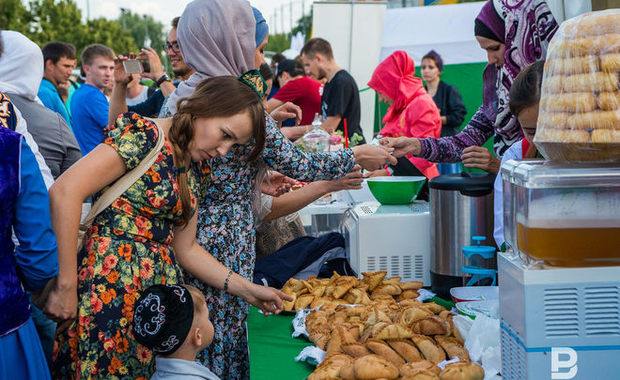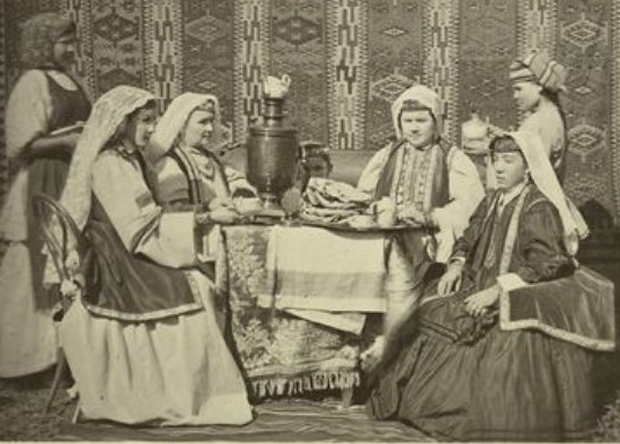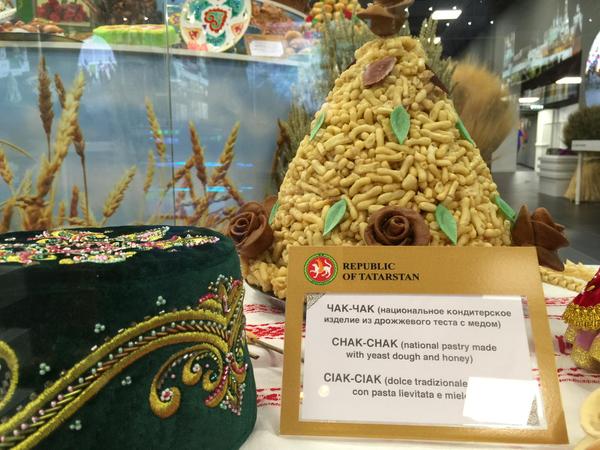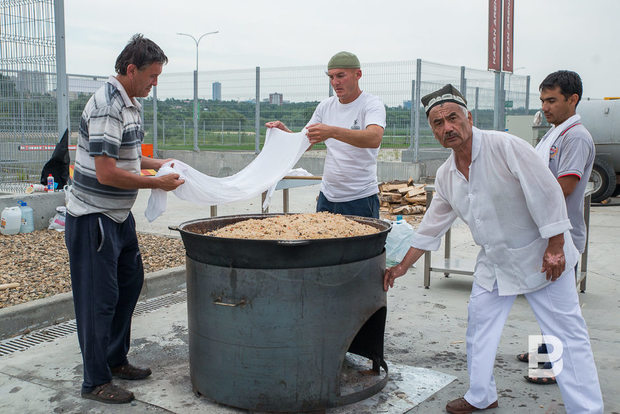Culinary brand genesis: how Uzbek samsa turned into Tatar echpochmak, and boortsog, into chack-chack
Tatar cuisine: history and modernity. Part 1
Today, Tatarstan offers a variety of food under the 'Tatar' brand. Tourists who come to Kazan, some patriots of the Tatar people, are ready to buy even all sorts of 'Tatar' ketchups, pizzas, vegetables, salads and sweets, which, in fact, disguise as 'national' cuisine. An ethnographer and our columnist Dina Gatina-Shafikova in today's newspaper column written specially for Realnoe Vremya tells us what famous dishes are 'right' and how they appeared in the cuisine of the Tatars in the course of the history.
From food of the nomads to food of the settled people
If you like after the tenth cup of black tea with milk to ask the eleventh one. If you can't imagine a weekend in a village without a traditional belish from ebi (grandmother in Tatar — editor's note). In the city you eat in the first Tatar fast food chain Tubetei, certainly festive shashlik, ideally from horse meat or mutton and you flavour it with ketchup 'Tatar' (a manufacturer doesn't matter). In that case, one can definitely say that you are a true Tatar. However, despite all these clichéd perceptions, in order to find out how actually looks the Tatar cuisine, what was borrowed and what was brought from generation to generation, we should take a step back from modern PR and turn to more sources and facts.
As well as cuisines of other peoples, the Tatar one is rich in tradition, it is diverse and has deep roots, dating back to the history of the people itself. The origin is nomadic (that is why they love meat and dairy products), and later ones – settled (grain crops appear — flour, cereals). The trade relations with the East, the East Asian countries were well developed, hence the abundance of Oriental sweets and spices, nuts and dried fruits, and the dishes like pilaf and samsa. Many of them have similar name and ways of cooking with the dishes of other Turkic peoples as a result of continuity and interaction.
The Tatar cuisine quite early adopted thermal cooking methods such as the oven, hearth and a cemented in cast-iron pot, which gave the opportunity to cook not only by boiling and frying in fat or oil but also by baking.

In the traditional cuisine, a set of basic products directly depends on natural conditions and economic activities of a people. Mostly living in the forest-steppe zone, the Tatars were engaged in animal husbandry and various crafts (hunting, fishing, bee-keeping, later — apiculture), plant growing (initially agriculture and later horticulture and gardening). Religion played not the last role in the dietary habits. The adoption of Islam led to the ban of some products (pork, meat of predatory animals, crayfish, etc.) and beverages (alcohol).
N. I. Vorobyev in his works on traditional culture noticed that the main products used by the Tatars are the following groups: meat, dairy products, poultry products (eggs), fats and products of plant industry. Most of food products were from the own farms, and only spices and fruits were purchased. A later acquisition — the plant growing, but the products of cattle breeding were used in greater number than by neighbouring peoples.
Meat is the stuff of life
The Tatars have used meat (cattle, poultry, game, horse meat) and offal (liver, tripe, tongue, etc.) as food since ancient times. Blood is not used. The most favourite meat — lamb, then — beef and horse meat. Goat meat was used only of young animals. Widespread among the wealthy population was poultry — chickens, geese, ducks, turkeys. The meat for the future was made by brining and drying. From horse meat they cooked kazylyk, dried goose and duck were considered to be a delicacy. In winter, meat was stored in frozen form (R. G. Mukhamedova). In the traditional cuisine, the meat was mostly boiled.
N.F. Katanov in the review of the literary activities of the Tatars in the 19 th century described an interesting annotation from medical books of 1895 edition with Tatar translation by the canons of the medieval Persian scientist, philosopher and physician Avicenna (Ibn Sina), i.e. for direct use by the population of The Book of medicine regarding the properties of certain drugs about the healing properties of meat — quail, rooster, chicken and hedgehog. For example, quail meat multiplies intelligence, chicken broth strengthens the stomach, hedgehog meat helps against fever and snake bites…

It cannot be said that the Tatars did not consume the fish, they did, especially the residents of the riverside areas, but the total range of fish dishes was rather narrow. Besides, R.G. Mukhamedova in her work indicated that the Tatars did not eat the burbot because it resembled a snake. According to popular belief, some other fish were also considered 'unclean', for example, pike and catfish, due to the fact that, as suggested, these fishes consumed carrion.
The Tatar cuisine is characterized by the use of a large number of animal fat, grease, oil (served with tea). Eggs of poultry, especially chicken, were also used in food. Milk and diary products were also held in high esteem by the Tatars. Milk was used in its raw form, it was also boiled, baked, fermented, added in tea and as a condiment for porridges and soups. After the processing they produced cream, butter, cheese, kort, katyk, etc.
Bread and porridge — our food
They also used grains as food – it is rye (the main product for the rural population was bread made of sour rye dough), wheat (only wealthy Tatar used wheat bread), barley, spelt, buckwheat, lentils, peas, millet, rice, oats (made kissel). Partly, from cereals they cooked porridge, used as a filling for pastries, and very rarely — as seasonings to liquid dishes.
The peculiarity of the use by the Tatars of the flour filling for the soup dates back to an earlier period (such filling was typical for many nomadic peoples), when the flour was just poured in the broth, later such seasoning transformed into decorated pieces of dough (dumplings, noodles).

Boortsog and chak-chak – 'our all'
Unleavened/rich dough was used for baked products: scones, muffins, pancakes, etc. They can be divided into several groups: bread; pastries without filling, but from batter, fried not baked; with filling. For example, most widespread was this dish such as boortsog, usually prepared from wheat flour and fried in fat or butter. Subsequently, boortsog transformed into famous chack-chack, where in addition to roasting it was added honey.
Peremech without meat?
Famous and loved peremech was not always prepared from meat. It could be different in size, composition of filling and method of cooking. The most simplified version was a crumpet covered in quark with powder from hemp seed, it could be stuffed with mashed potatoes. And only third most common type was with the meat and onions. It was cooked either in the oven or by frying in oil. And these are only the main varieties, in different villages there were sometimes very different recipes for this dish. At the same time, peremech was typical for all segments of the population, especially as a festive treat for tea. Served hot or cold.
Transformation from belish to echpochmak
Another, no less famous pastry — belish, was originally a pie at a diameter of 10-15 cm with filling. The edges were high, up to 7-10 cm, were bent to the center, but had not joined together, and it was inserted a separate plate that closed completely unconnected edges. K. and M. Gubaidullins, describing the round shaped belish, drew analogies with the felt yurt, and a square one — like a truncated pyramid. The filling could be varied, but most often it was meat with potatoes, rice or spelt.
Subsequently, adopting the shape of samsa, but leaving the usual for the Tatars filling, such pastries turned into a familiar for us echpochmak. The closed pies of large size were prepared of oval or semicircular shape, with vegetable or vegetable and cereal fillings — bekken or teke.

The recipe of the Tatar pilaf
As a holiday meal, the wealthy Tatars liked to cook pilaf that came from Central Asia. Even Kayum Nasyry described how to cook the Tatar pilaf: '...melt the butter or grease in a hot pot, then put finely chopped cooked meat, top with carrots and onions and, finally, rice. Then not stirring, leave to simmer in a closed pot for 1-1,5 hours. Before serving, put raisins or dried apricots boiled in water.'
To be continued